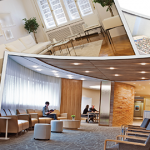The current managed care environment and declining reimbursement rates are forcing physicians to see more patients to break even. With a constant stream of new patients and appointments booked back to back, waiting has become an unavoidable patient experience in healthcare. In fact, many patients spend more time in the waiting room than in an exam room with a physician.
When was the last time you spent time in your waiting room? If you are like most physicians, you enter and exit your practice through an alternate entry and, as a result, you rarely see the waiting room that generates first impressions and sets the tone for the visit.
Seeing your waiting room as your patients do is vitally important to your business because your waiting room creates clues to what kind of care a patient can expect. This room should be representative of the excellent care you provide, not a cold, disheveled, or out-of-date holding station
Walk the Walk and Sit the Sit
Walk through your own front door and examine your waiting room. Does it set the stage for a successful and efficient patient encounter, or does it leave a negative first impression? Patient perception and first impressions must be considered in order to create and build a trusting patient–physician relationship. Healthcare design specialist Jain Malkin believes that, “Even if patients are not consciously aware of the message they are getting from office interior design, they are subconsciously reading it. The body language of the office environment tells patients things that might subconsciously undermine their confidence in a physician.”1
In addition, shopping for medical care is routine, and emerging “Travelocity”-style physician rating systems give patients more power to share their perception of quality, care, and satisfaction with other medical consumers. Understanding some common subliminal cues found in your waiting room will allow you to make a few low- or no-cost upgrades to your office that will help to set your patients at ease and will foster an environment conducive to a successful and efficient patient visit.
In her book, Medical and Dental Space Planning: A Comprehensive Guide to Design, Equipment, and Clinical Procedures, Malkin describes the following common office décor faux pas and what they may suggest to patients.
- Waxy or dusty plastic plants may suggest that live plants probably could not survive in the environment and that the patient may fare no better. Instead, display healthy greenery to promote a feeling of well-being. Live potted plants, fresh cut floral arrangements, or upgraded faux greenery that appears real and is cleaned often are a good substitution for traditional green plastic plants.
- A poorly illuminated waiting room or burned-out light bulbs suggest to patients that the staff is trying to hide something. Conversely, lighting that is too bright is an irritant. Have a staff member look over the waiting area every morning to identify and replace burned-out bulbs. Replace dim lighting and overly bright lighting with a soothing bulb that is bright enough for reading but not an irritant.
- A closed sliding-glass buzzer for service suggests that the patient is not welcome and that they are intruding on the staff’s privacy. The receptionist should always remain in view of the waiting area and be accessible.
- Soiled carpet and upholstery suggest that the medical facility overlooks or ignores details or, worse, the facility operates under unsanitary conditions. Schedule regular professional cleanings and check the waiting room often to identify spills and soiled areas.
- Out-of-date furniture, worn upholstery, and grimy spots on walls suggest that the doctor does not care about the patient’s comfort or that he or she is reluctant to replace things when they wear out. It may also suggest that the doctor is outdated on medical matters. A fresh coat of paint is the easiest and often the cheapest way to upgrade your office and give it a fresh, clean feel. If you initially furnished your office with trendy items that are now out of date, consider budgeting for an upgrade. Choose classic sturdy pieces in solid neutral tones and fabric that can be easily cleaned and will stand the test of time. If you are not prepared to replace your furnishings, try professional cleaning or recovering furniture for a less expensive upgrade.
Get Started
Now that you’ve stepped out from behind the great clinical divide and into the waiting area, do you see some of these issues in your own office? Where do you start? How do you refresh the waiting area and create a more hospitable environment, even on a limited budget?
ACR Practice Management Specialist Itara Barnes says, “Start with those small items that you can do on your own. You will be amazed with how far a fresh coat of paint and deep cleaning will go in creating a fresh, clean, updated office. Then create a plan to replace and refurbish larger and more costly items, starting with those that will make the largest impact. For example, dated furniture will look much better on fresh carpet or flooring than new furniture on soiled and dated carpet. It is not necessary to completely renovate your reception area in one weekend. Simply acknowledging the problems that exist and creating a plan of action will put your practice on the path to recovery.”
For more information on improving patient relations, contact Barnes in the ACR’s practice management department at [email protected] or (404)633-3777.


